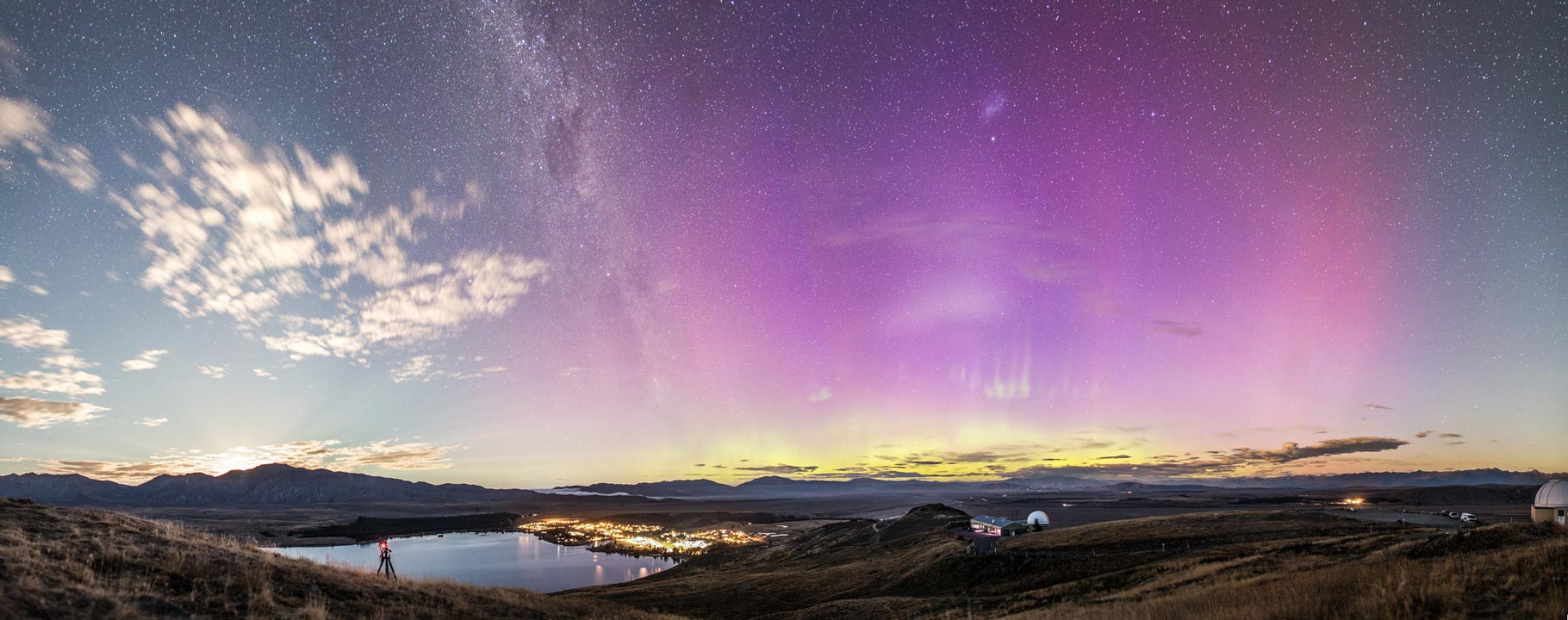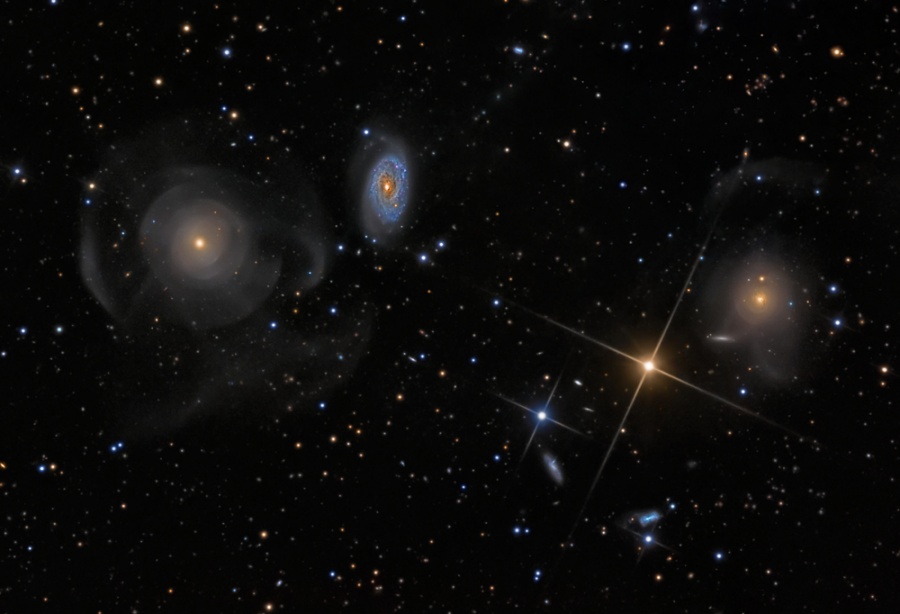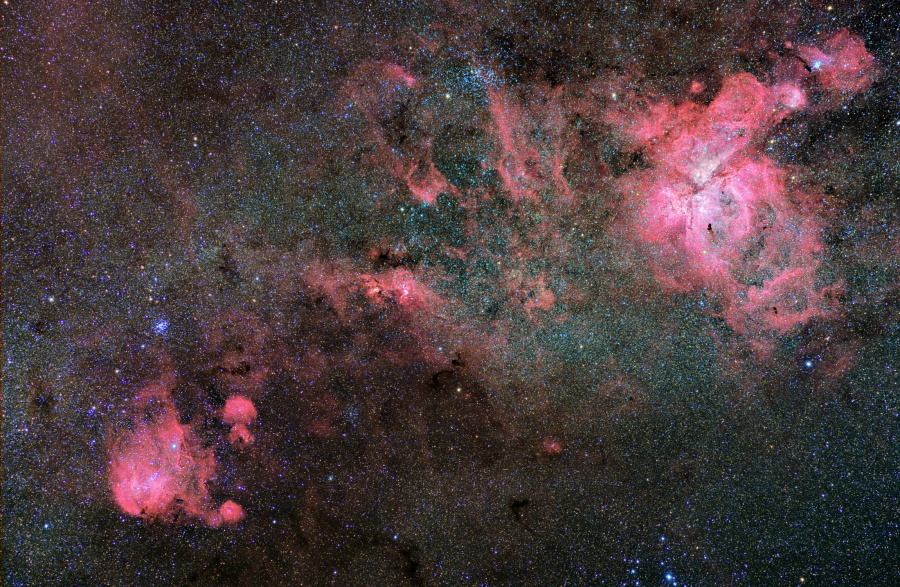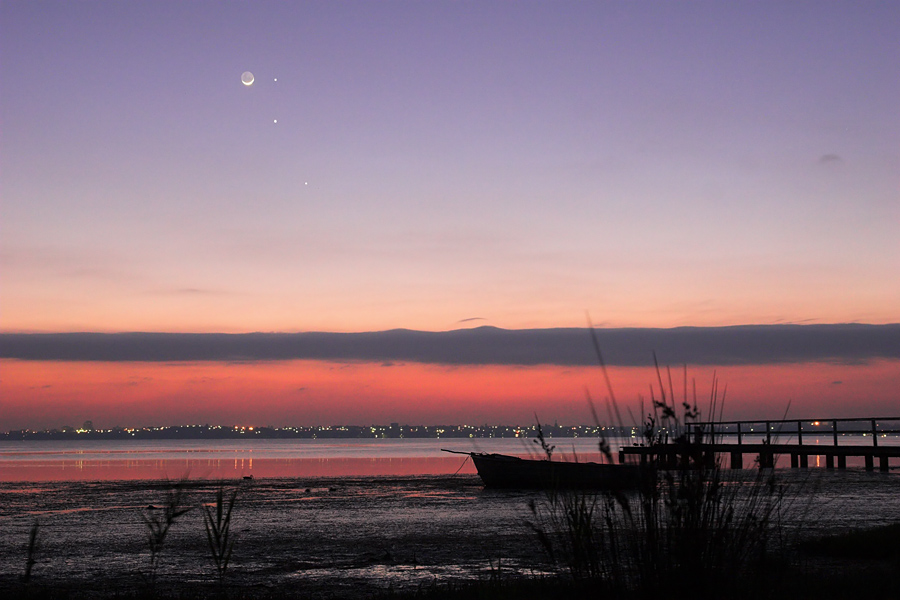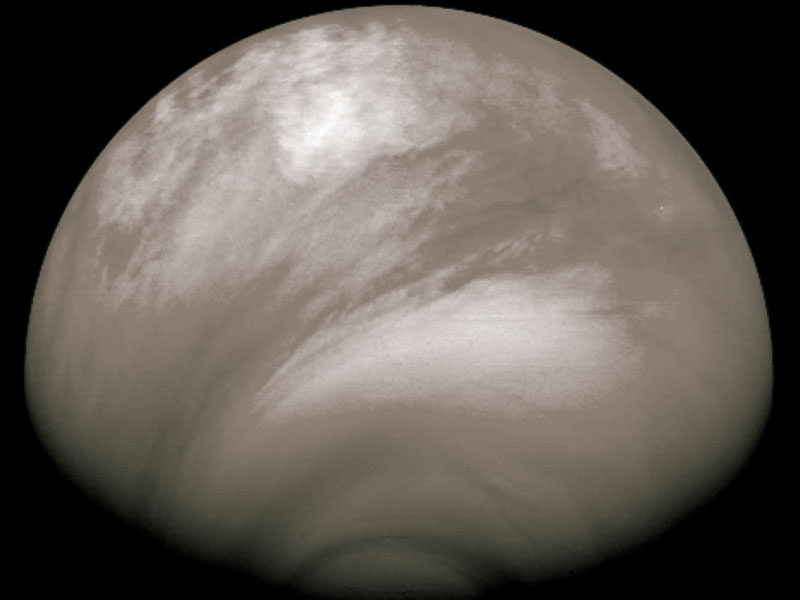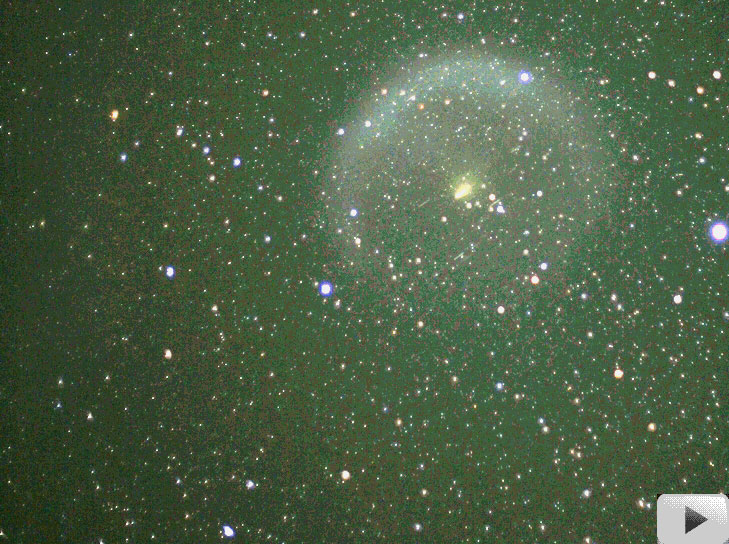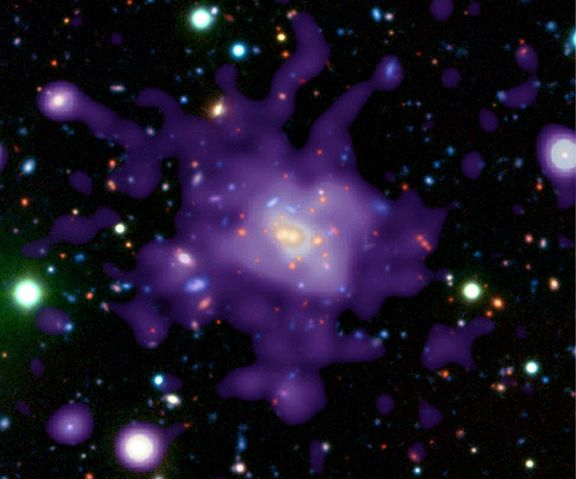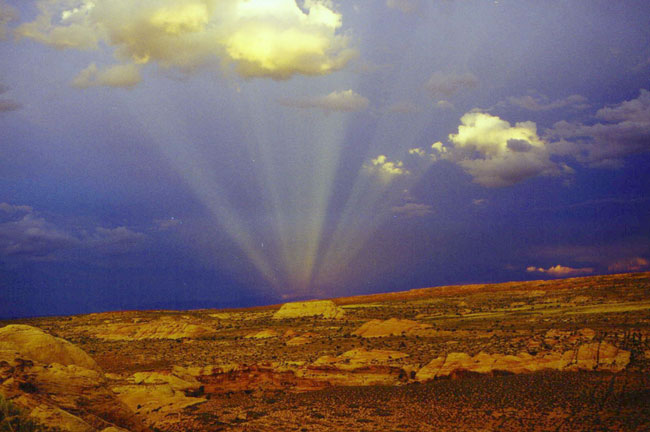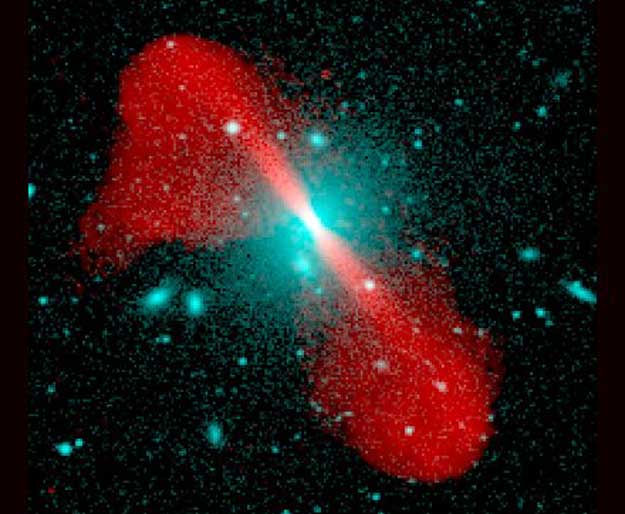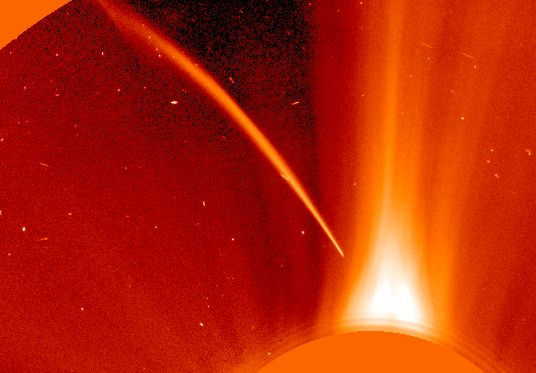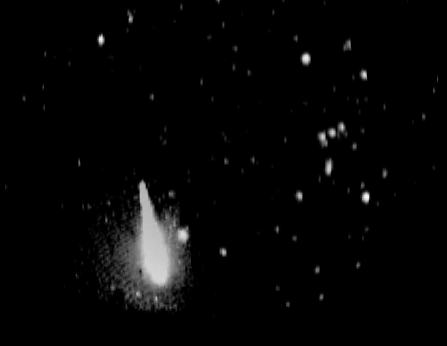| << Previous | Index | Next >> |
2015Venus, named for the Roman goddess of love, and Mars, the war god's namesake, came together by moonlight in this lovely skyview, recorded on February 20 from Charleston, South Carolina, USA, planet Earth. Made in twilight with a digital camera, the three second time exposure also records earthshine illuminating the otherwise dark surface of the young crescent Moon. Of course, the Moon has moved on from this much anticipated triple conjunction. Venus still shines in the west though as the evening star, third brightest object in Earth's sky, after the Sun and the Moon itself. Seen here within almost a Moon's width of Venus, much fainter Mars approached even closer on the following evening. But Mars has since been moving slowly away from brilliant Venus, though Mars is still visible too in the western twilight.
2014 Sometimes the more you look at an image, the more you see. Such may be the case for this beautiful nighttime panorama taken last week in New Zealand. Visible right off, on the far left, are common clouds, slightly altered by the digital fusion of combining 11 separate 20-second exposures. More striking, perhaps, is the broad pink aurora that dominates the right part of the image, a less common auroral color that is likely tinted by excited oxygen atoms high in Earth's atmosphere. Keep looking and you might notice a bright light just beyond the mountain on the left. That is the rising Moon -- and an even closer look will reveal faint crepuscular rays emanating from it. Musing over the image center may cause you to notice the central band of the Milky Way Galaxy which here appears to divide, almost vertically, the left clouds from the right aurora. Inspecting the upper right of the image reveals a fuzzy patch, high in the sky, that is the Small Magellanic Cloud. Numerous stars discretely populate the distant background. Back on Earth, the image foreground features two domes of the Mt. John University Observatory and a camera tripod looking to capture much of this scene over a serene Lake Tekapo.
2013
Click to play embedded YouTube video.
Video Credit: Solar Dynamics Observatory, SVS, GSFC, NASA; Music: Thunderbolt by Lars Leonhard
2012 What's causing those odd rings in supernova 1987A? Twenty five years ago, in 1987, the brightest supernova in recent history was seen in the Large Magellanic Cloud. At the center of the above picture is an object central to the remains of the violent stellar explosion. Surrounding the center are curious outer rings appearing as a flattened figure 8. Although large telescopes including the Hubble Space Telescope monitor the curious rings every few years, their origin remains a mystery. Pictured above is a Hubble image of the SN1987A remnant taken last year. Speculation into the cause of the rings includes beamed jets emanating from an otherwise hidden neutron star left over from the supernova, and the interaction of the wind from the progenitor star with gas released before the explosion.
2011 This colorful cosmic skyscape features a peculiar system of galaxies cataloged as Arp 227 some 100 million light-years distant. Swimming within the boundaries of the constellation Pisces, Arp 227 consists of the two galaxies prominent on the left; the curious shell galaxy NGC 474 and its blue, spiral-armed neighbor NGC 470. The faint, wide arcs or shells of NGC 474 could have been formed by a gravitational encounter with neighbor NGC 470. Alternately the shells could be caused by a merger with a smaller galaxy producing an effect analogous to ripples across the surface of a pond. Remarkably, the large galaxy on the right hand side of the deep image, NGC 467, appears to be surrounded by faint shells too, evidence of another interacting galaxy system. Intriguing background galaxies are scattered around the field that also includes spiky foreground stars. Of course, those stars lie well within our own Milky Way Galaxy. The field of view spans 25 arc minutes or about 1/2 degree on the sky.
2010 A jewel of the southern sky, the Great Carina Nebula, aka NGC 3372, spans over 300 light-years. Near the upper right of this expansive skyscape, it is much larger than the more northerly Orion Nebula. In fact, the Carina Nebula is one of our galaxy's largest star-forming regions and home to young, extremely massive stars, including the still enigmatic variable Eta Carinae, a star with well over 100 times the mass of the Sun. Nebulae near the center of the 10 degree wide field include NGC 3576 and NGC 3603. Near center at the top of the frame is open star cluster NGC 3532, the Wishing Well Cluster. More compact, NGC 3766, the Pearl Cluster, can be spotted at the left. Anchoring the lower left of the cosmic canvas is another large star-forming region, IC 2948/2944 with embedded star cluster Collinder 249. That region is popularly known as the Running Chicken Nebula.
2009 When the Moon rose in predawn skies on February 23rd, it sported a sunlit crescent. It also offered early morning risers a tantalizing view of earthshine, the dark portion of the lunar disk illuminated by sunlight reflected from the Earth. Of course, on that morning a remarkable conjunction with three wandering planets added an impressive touch to the celestial scene. Recorded just before sunrise, this serene skyview looks east toward a glowing horizon across Tuggerah Lake on the Central Coast of New South Wales, Australia. Along with the waning crescent Moon, the picture captures (top to bottom) bright Mercury, Jupiter, and Mars.
2008 Why did an acidic haze spread across Venus? The unusual clouds were discovered last July by ESA's robotic Venus Express spacecraft currently orbiting Venus. The bright and smooth haze was found by Venus Express to be rich in sulfuric acid, created when an unknown process lifted water vapor and sulphur dioxide from lower levels into Venus' upper atmosphere. There, sunlight broke these molecules apart and some of them recombined into the volatile sulfuric acid. Over the course of just a few days last July, the smooth acidic clouds spread from the South Pole of Venus across half the planet. The above false-color picture of Venus was taken last July 23rd in ultraviolet light, and shows the unusual haze as relatively smooth regions across the image bottom. The cause of the dark streaks in the clouds is also not yet understood and is being researched.
2007 What's that cloud drifting in space? It's not an astronomical nebula -- those appear to stay put. Atmospheric clouds don't look like this. The answer to last week's sky mystery turned out to be orbiting and expanding debris from the upper stage of a failed Russian rocket that exploded unexpectedly. The cloud became visible to unaided southern hemisphere observers, and its cause was initially unknown. The above time lapse movie shows the cloud drifting as seen from Australia. Streaks in and near the cloud are likely large pieces of debris. The debris cloud is more than an astronomical curiosity -- particles from this cloud and others could become projectiles damaging existing satellites. As the cloud disperses, many particles will fall to Earth, but many more may help make low Earth orbit an increasingly hostile environment.
2006 From afar, the whole thing looks like an Eagle. A closer look at the Eagle Nebula, however, shows the bright region is actually a window into the center of a larger dark shell of dust. Through this window, a brightly-lit workshop appears where a whole open cluster of stars is being formed. In this cavity tall pillars and round globules of dark dust and cold molecular gas remain where stars are still forming. Already visible are several young bright blue stars whose light and winds are burning away and pushing back the remaining filaments and walls of gas and dust. The Eagle emission nebula, tagged M16, lies about 6500 light years away, spans about 20 light-years, and is visible with binoculars toward the constellation of Serpens. The above picture combines three specific emitted colors and was taken with the 0.9-meter telescope on Kitt Peak, Arizona, USA.
2005 Scientific images of cosmic dust clouds or even frozen water can be esthetic too. In fact, this picture of thin layers of forming ice crystals uses a scientific understanding of light's wave properties solely for artistic purposes. Titled "Illume", the picture was created by astrophysicist Peter Wasilewski. To make the picture, the crystals were illuminated by light shining through a polarizing filter -- a filter that restricts the otherwise randomly oriented light waves to vibrate in only one direction. While passing through the ice, different colors of the polarized light are then refracted and reflected along slightly different paths by the delicate crystalline layers. Viewing the scene with a second polarizing filter brings out the wondrous display of structure and color. Painting with "light, the laws of physics, and an attitude" Wasilewski has created a series of these evocative ice images that he refers to as Frozen Vision or Frizion.
2004 Long before medieval alchemists dreamed of transmuting base metals to gold, stellar furnaces in this massive cluster of galaxies - cataloged as RDCS 1252.9-2927 - had transformed light elements into heavy ones. In the false-color composite image individual cluster galaxies can be seen at optical and near-infrared wavelengths, shown in red, yellow, and green colors. X-ray data (in purple) reveal the hot intracluster gas, enriched in heavy elements. Attracting the attention of astronomers using the orbiting Chandra and XMM-Newton x-ray telescopes, as well as the Hubble Space Telescope and ground based VLT, the galaxy cluster lies nearly 9 billion light-years away ... and so existed at a time when the Universe was less than 5 billion years old. A measured mass of more than 200 trillion Suns makes this galaxy cluster the most massive object ever found when the Universe was so young. The cluster elemental abundances are consistent with the idea that most heavy elements were synthesized early on by massive stars, but current theories suggest that such a massive cluster should be rare in the early Universe.
2003 What's happening over the horizon? Although the scene may appear somehow supernatural, nothing more unusual is occurring than a setting Sun and some well placed clouds. Pictured above are anticrepuscular rays. To understand them, start by picturing common crepuscular rays that are seen any time that sunlight pours though scattered clouds. Now although sunlight indeed travels along straight lines, the projections of these lines onto the spherical sky are great circles. Therefore, the crepuscular rays from a setting (or rising) sun will appear to re-converge on the other side of the sky. At the anti-solar point 180 degrees around from the Sun, they are referred to as anticrepuscular rays. While enjoying the sunset after dinner near Horseshoe Canyon in Utah, the photographer chanced to find that an even more spectacular sight was occurring in the other direction just over the canyon -- a particularly vivid set of anticrepuscular rays.
2002 Jets of streaming plasma expelled by the central black hole of a massive elliptical galaxy likely light up this composite image of 3C296. The jets emanating from NGC 5532 and are nearly a million light years long. Exactly how the central black hole expels the infalling matter is still unknown. After clearing the galaxy, however, the jets inflate large radio bubbles that could glow for millions of years. If excited by a passing front, radio bubbles can even light up again after a billion years. Visible light is depicted in the above image in blue, while radio waves are shown in red. The radio map was created with the Very Large Array of radio telescopes.
2001 Sand dunes on Mars can appear exotic. The dark dunes above might be compared to shark's teeth or chocolate confections. In reality, they arise from the complex relationship between the sandy surface and high winds on Mars. These particular dunes are located in Proctor Crater, a 170 kilometer wide crater first seen to house sand dunes by Mariner 9 more than 25 years ago. The above picture was taken by Mars Global Surveyor (MGS), a robot spacecraft currently in orbit around Mars. MGS has recently completed a primary goal of taking and transmitting detailed survey images of the red planet over an entire Martian year (669 Earth days). MGS will now be deployed to study particularly interesting regions of Mars in more detail.
2000 What killed the dinosaurs? Their sudden disappearance 65 million years ago, along with about 70 percent of all species then living on Earth, is known as the K-T event (Cretaceous-Tertiary Mass Extinction event). Geologists and paleontologists often entertain the idea that a large asteroid or comet impacting the Earth was the culprit. In such a cosmic catastrophe, the good(!) news would be that the impact would generate firestorms, tidal waves, earthquakes, and hurricane winds. As for the bad news ... debris thrown into the atmosphere would have a serious global environmental consequences, creating extended periods of darkness, low temperatures, and acid rains - resulting in a planet-wide extinction event. In 1990, dramatic support for this theory came from cosmochemist Alan Hildebrand's revelation of a 65 million year old, 112 mile wide ring structure still detectable under layers of sediment in the Yucatan Peninsula region of Mexico. The outlines of the structure, called the Chicxulub crater (named for a local village), are visible in the above representation of gravity and magnetic field data from the region. In addition to having the right age, the crater is consistent with the impact of an asteroid of sufficient size (6 to 12 miles wide) to cause the global disruptions. Regardless of the true cause of the K-T event, it is fortunate that such impacts are presently believed to happen only about once every 100 million years!
1999 Ominously foreshadowing events to come, a dark cloud of obscuring dust stands out against a luminous star field in the Milky Way. Cataloged as Feitzinger and Stuwe object "1-457" this fuliginous interstellar nebula is relatively close - possibly only 1,000 light-years distant. Near its core it is dense enough to block almost all of the light from the numerous, more distant stars visible toward the galactic center region. In addition to dust grains, dark nebulae which abound in the plane of our Galaxy are likely to contain interstellar gas and represent potential raw material for future star formation.
1998 From horizon to horizon, the night sky above Loomberah, New South Wales, Australia was photographed by astronomer Gordon Garradd on March 22, 1996. Garradd used a home made all-sky camera with a fish-eye lens, resulting in a circular 200 degree field of view. This gorgeous sky view is dominated by the luminous band of the Milky Way cut by dramatic, dark interstellar dust clouds. Along with the bright stars of our Galaxy, the Large Magellanic Cloud is visible at the upper right (about 1 o'clock) and the long, lovely, bluish tail of comet Hyakutake can be seen toward the bottom of the image, near the bright star Arcturus. Bright city lights from nearby Tamworth glow along the Northwestern horizon.
1997 Arcing toward a fiery fate, this Sungrazer comet was recorded by the SOHO spacecraft's Large Angle Spectrometric COronagraph (LASCO) on Dec. 23rd, 1996. LASCO uses an occulting disk, partially visible at the lower right, to block out the otherwise overwhelming solar disk allowing it to image the inner 5 million miles of the relatively faint corona. The comet is seen as its coma enters the bright equatorial solar wind region (oriented vertically). Spots and blemishes on the image are background stars and camera streaks caused by charged particles. Positioned in space to continuously observe the Sun, SOHO has detected 7 sungrazing comets. Based on their orbits, they are believed to belong to a family of comets created by successive break ups from a single large parent comet which passed very near the sun in the twelfth century. The bright comet of 1965, Ikeya-Seki, was also a member of the Sungrazer family, coming within about 400,000 miles of the Sun's surface. Passing so close to the Sun, Sungrazers are subjected to destructive tidal forces along with intense solar heat. This comet, known as SOHO 6, did not survive.
1996 On rare but spectacular occasions, fireballs, meteors brighter than the brightest stars, flash through the heavens - sometimes making audible sounds and occasionally surviving to strike the Earth's surface. The path of one such fireball, recorded last year in January skies over Hannover Germany is shown above, the brilliant meteor easily outshining the stars of the constellation Orion (visible at the far right). In fact, for this brief moment Sirius, the brightest star in the night sky, is overwhelmed as the image of the fireball grazes it. This dramatic event was recorded by a video camera observation technique known as MOVIE. Interplanetary space is littered with meteoroids, "rocks" tens of yards in diameter and less. Striking the Earth's atmosphere at high relative speeds, they leave visible trails known as meteors or, more poetically, "shooting stars". The trails are created when the intense heat caused by friction vaporizes them. Fireballs can be caused by meteroids weighing small fractions of an ounce which do not survive to reach the ground. Remnants of larger ones, which do reach the ground after running this fiery gauntlet, are called meteorites. Though fireballs are rare, meteors are visible on any clear night of the year. Even outside the predicted regular meteor shower events, patient observers in dark sky areas can see several an hour - by just looking up! Sightings of fireballs should be reported.
| << Previous | Index | Next >> |

